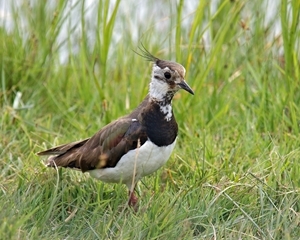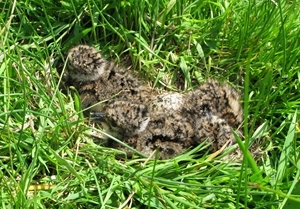 A 1.25 MILLION Euro EU Life+ funded project will help farmers in the Avon Valley between Salisbury and Christchurch reverse the fortunes of the iconic and much revered lapwing, which has suffered a dramatic decline over the past 20 years. The species is red-listed as a bird of conservation concern in the UK and conservationists believe that as well as habitat loss, predation of nests by foxes and crows is a major factor limiting lapwing recovery.
A 1.25 MILLION Euro EU Life+ funded project will help farmers in the Avon Valley between Salisbury and Christchurch reverse the fortunes of the iconic and much revered lapwing, which has suffered a dramatic decline over the past 20 years. The species is red-listed as a bird of conservation concern in the UK and conservationists believe that as well as habitat loss, predation of nests by foxes and crows is a major factor limiting lapwing recovery.
The project, which involves 35 farmers, is being managed by the Game & Wildlife Conservation Trust (GWCT), in partnership with the Hampshire & Isle of Wight Wildlife Trust and Planning for Real.
 The Avon Valley has historically supported nationally important populations of breeding waders, including lapwing, redshank, and common snipe. In the 1980s, the valley was one of the top eight lowland wet grassland sites for breeding waders in the UK. However, despite habitat improvements aimed at waders, populations of lapwing have fallen from 260 breeding pairs in the 1980s to about 90 last year.
The Avon Valley has historically supported nationally important populations of breeding waders, including lapwing, redshank, and common snipe. In the 1980s, the valley was one of the top eight lowland wet grassland sites for breeding waders in the UK. However, despite habitat improvements aimed at waders, populations of lapwing have fallen from 260 breeding pairs in the 1980s to about 90 last year.
The key aim of the four-year ‘Waders for Real’ project is to increase the breeding success of lapwings and redshank, so that more young are fledged and numbers of breeding pairs start to increase.
Currently in lowland England, breeding wader populations are only being maintained on nature reserves. This project aims to demonstrate the feasibility of restoring wader populations in the wider countryside by implementing a combination of habitat improvements and measures to reduce nest and chick predation. It is hoped that the experience gained will feed into future Government agri-environment schemes.
Dr Andrew Hoodless, Head of Wetland Research with the Game & Wildlife Conservation Trust, has been monitoring the plight of waders in the Valley and explains the urgency of this project, “In common with other wetland areas, the numbers of breeding waders in the Avon Valley has declined dramatically since the early 1980s. Monitoring has recorded lapwing declines of 64%, redshank of 75% and snipe of 97%. Despite the farmers in the valley carrying out a variety of habitat restoration measures over the last 20 years, there has been no reversal of these declines.”
Monitoring of lapwing nests using temperature loggers indicates that in the Avon Valley 61% of nesting attempts fail and that 82% of nest failure is caused by predation, particularly by foxes at night and crows and gulls during the day.
Dr Hoodless explains, “The project is challenging because we are working across such a large area. Our data on lapwing breeding success, collected on 15 farms within the Avon Valley, clearly shows that poor breeding success is driving the decline. Lapwing productivity here has averaged just 0.41 fledged young per pair and this is well below the threshold average of 0.70 fledged young per pair needed to maintain a stable population.”
Initially, the GWCT and the Hampshire and Isle of Wight Wildlife Trust will be working intensively with farmers to create four ‘hot spot’ areas for re-colonization and will be providing comprehensive advice to the remaining farmers within the Avon Valley. Within the ‘hot spot’ areas, farmers will implement habitat management to improve brood rearing areas, but also to minimise predator access. Monitoring of predator numbers will help identify habitat manipulation on a site specific basis and non-lethal measures, such as nest cages to protect eggs from foxes and crows, will be deployed. In addition to these measures, two areas will also carry out predator control and the GWCT will be providing advice and training with the aim of assessing its effect. The Life+ funding does not cover this element of the project.
Dr Hoodless explains the significance of this innovative four-year project, “There is no doubt that lapwings and other waders are in serious trouble. We have mostly identified the causes, but we need to work more closely with farmers to come up with practical and effective solutions for farmland outside of nature reserves. Guidance that can be tailored to individual circumstances as well as the commitment of farmers to reversing declines, will be crucial to securing the future of these wonderful birds.”
END
Photocaption: (picture credit: Andrew Hoodless, GWCT). Monitoring of lapwing nests using temperature loggers indicates that in the Avon Valley 61% of nesting attempts fail and that 82% of nest failure is caused by predation, particularly by foxes at night and crows and gulls during the day.
Notes to editors
The Game & Wildlife Conservation Trust – providing research-led conservation for a thriving countryside. The GWCT is an independent wildlife conservation charity which has carried out scientific research into Britain’s game and wildlife since the 1930s. We advise farmers and landowners on improving wildlife habitats. We employ more than 60 post-doctoral scientists and other research staff with expertise in areas such as birds, insects, mammals, farming, fish and statistics. We undertake our own research as well as projects funded by contract and grant-aid from government and private bodies.
For information, contact:
Eleanor Williams
Telephone: 07592 025476
Email: press@gwct.org.uk